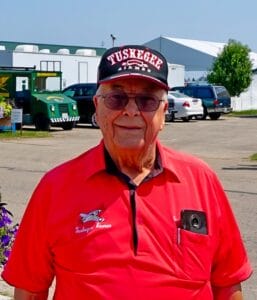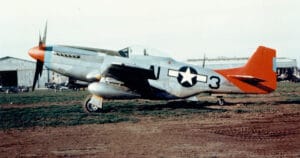Growing up in Philadelphia, when Hardy graduated high school the U.S. was full swing into World War II, and his older brother had joined the Navy. Hardy decided against the Navy: he had seen newsreels of air combat over Europe, and that held more interest. But he was too young to enlist, and traveled to Chester, Pa., as he heard a manufacturer there was desperate for employees. He went to a job fair, “And someone said, ‘Yes, and these jobs are so critical that you’ll be exempted from the draft’,” he said many years later. “At the next break, I left. They never heard from me again: I wanted to go into the service because all of my friends were in the service.” As soon as he turned 18, he joined the U.S. Army Air Corps. He was sent for flight training at Tuskegee (Ala.) Army Air Field, which was designed by Hilyard Robinson, a Black architect. The field was so needed that training started before the runway could even be paved.

He also attended Basic training (at Keesler Army Air Field in Biloxi, Miss.), and was commissioned as a second lieutenant. Then it was off to Walterboro Army Air Field in South Carolina to train for combat, where he qualified in single-engine fighter planes, and then sent to Italy — as part of the “Red Tails” of the 332nd Fighter Group based at Ramitelli Airbase. He flew 21 combat missions over Germany in 1945, mostly flying the P-51D Mustang as bomber escort of B-17 and B-24 heavy bombers. After the war, Hardy went back to Tuskegee to train pilots. He was discharged after the war, but recalled in 1948, now into the U.S. Air Force. After additional training at Keesler, he was deployed to Guam with the 19th Bomb Group, then to Okinawa, to fly 45 combat missions to Korea, now flying a B-29 bomber. Early on, he was pulled from a mission because a commander, Lt. Col. Fred W. Miller, didn’t want a Black pilot. “That was the first B-29 shot down in the war,” Hardy said later. “Two were captured, and one of those died as a POW. But that was my crew.” While many white bomber pilots refused to even talk with the Tuskegee Airmen on the ground, when it came time to fly a mission, they would often specifically request “Red Tails” as their escorts — they were some of the best fighter pilots of the war.

After that war, Hardy stayed in the Air Force, and attended the U.S. Air Force Institute of Technology, where he earned a Bachelor of Science degree in electrical engineering (1957) and a Master of Science degree in systems engineering-reliability (1964). He was then sent to Vietnam, where he flew 70 missions in a C-119 gunship, flying at night to destroy North Vietnamese supply routes and convoys in Laos and Cambodia. And he ran into the same commander that pulled him from the flight over Korea, Col. Miller. “He became one of the best commanders I’ve served under, as far as I’m concerned,” Hardy said. “So things do change. It’s good to see changes like that. But to experience the problem to start with, it’s not easy.” Hardy retired as a Lt. Colonel in 1971, and went to work as a program manager for GTE, retiring again after 18 years there. Act 3 was to travel the country to give talks about the Tuskegee Airmen. Hardy was the last of the Tuskegee Airmen who flew in combat in World War II. He died in Sarasota, Fla., on Sept. 25, at 100.
